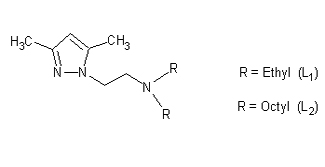Characterization of new pyrazole ligands functionalized with amine chains

This article focuses on the synthesis and characterisation of Pd (II) and Pt (II) mononuclear compounds with two new pyrazole ligands functionalised with amines. The research group led by Josefina Pons of the Department of Chemistry, carried out an exhaustive study describing the behaviour of these new ligands, which greatly facilitate future research on the applications of these types of complexes.
The aim of the Coordination Chemistry is to study the compounds formed between metal ions and other neutral or negatively charged molecules. The coordination chemistry was pioneered by Nobel Prize winner Alfred Werner (1866-1919). He received the Nobel Prize in 1913 for his coordination theory of transition metal-amine complexes.[1]
The importance of the Coordination Chemistry lies on their industrial applications in different fields such as catalysis and nanoparticle’s synthesis among others. The knowledge of the chemistry properties of the coordination compounds, in the solid state or in solution, makes possible their application in the commented fields or others. On the 80s their importance was also increased in the bioinorganic fields, which aim is to study the interactions between the metal ions and biomolecules.[2] The electronic features and chemical structure studies of the coordination complexes may help us to understand the biological activity of the natural systems as well as the chemical processes involved.
Coordination chemistry of pyrazole ligands has been widely developed during the last years.[3] Pyrazole ligand is a heterocyclic compound which consists of a planar ring of 5 members with two nitrogen atoms in relative positions 1 and 2. The incorporation of groups with different donor atoms in N1 position can increase the coordination ability of these ligands. In this way, a great variety of hybrid pyrazole ligands can be obtained with different functional groups which present different affinities for various metal cations leading to a wide range of application fields: metal ions extraction,[4] bioinorganic chemistry in which pyrazole derived ligands appear coordinated to different molecules with biological activity,[5] in agrochemistry,[6] in colorant manufacture,[7] in the photography field,[8] in polymer development,[9] in magnetochemistry studies,[10] in catalysis…[11]
The main objective of the present article is based on the synthesis and characterization of palladium(II) and platinum(II) mononuclear compounds with two new pyrazole ligands functionalized with amine chains at N1 position of the pyrazole ring (Figure 1, (alkylamino)pyrazole ligands). The aim of the work is not to describe the possible applications of these compounds but study and describe the behavior of the new ligands towards Pd(II) and Pt(II) with interest in future applications.
Two new (alkylamino)pyrazole derived ligands N1-substituted by diamine chains, (L1 and L2) were synthesized and their coordination with Pd(II) and Pt(II) has been described. Using different characterization techniques such as elemental analyses, conductivity measurements, infrared spectroscopy, nuclear magnetic resonance (at different temperatures) and X-ray diffraction methods, the coordination behavior of both ligands has been concluded (Figure 2). Both coordination modes involve a formation of a six-membered ring where the metal is coordinated by pyrazolic nitrogen, amine nitrogen and two chlorine atoms in a cis disposition in a square planar geometry.
The presented work enrich the knowledge of the behavior of (alkylamino)pyrazole ligands toward metals like Pd(II) and Pt(II) which should be of high importance for their further applications.
[1] A. Werner, Nobel Lecture, 1913.
[2] M. Itoh, K. Motoda, K. Shindo, T. Kamiusuku, H. Sakiyama, N. Matsumoto, H. Okawa, J. Chem. Soc., Dalton Trans. (1995), 3635.
[3] (a) T. Steiner, Angew. Chem., Int. Ed. (2002) 41, 48; (b) M.A. Halcrow, Dalton Trans. (2009) 2059; (c) R. Mukherjee, Coord. Chem. Rev. 203 (2000) 151.
[4] S. Trofimenko, Prog. Inorg. Chem. (1986), 34, 115.
[5] F. Mani, Coord. Chem. Rev. (1992) 120, 325.
[6] S. Okui, N. Kyomura, T. Fukuchi, K. Okano, L. He, A. Miyauchi, PCT Int. Appl. (2002), 56.
[7] D. Rose, F. Naumann, B. Meinigke, H. Hoeffkes, PCT Int. Appl. (2002), 35.
[8] D. Beaumond, M.D. Lloyd, B. Thomas, J. Photogr. Sci. (1984), 32, 127.
[9] P.E. Cassidy. “Thermally Stable Polymers” Dekker, New York, 1980.
[10] J. Pons, F.J. Sánchez, A. Labarta, J. Casabó, F. Teixidor, A. Caubet, Inorg. Chim. Acta (1993), 208, 167.
[11] V. Montoya, J. Pons, J. García-Antón, X. Solans, M. Font-Bardía, J. Ros, Organometallics (2007) 3183.
References
"Synthesis, X-ray crystal structure and NMR characterisation of mononuclear Pd(II) and Pt(II) complexes of didentate ligands with NN '-donor set". Pons, Josefina; Aragay, Gemma; García-Antón, Jordi; Calvet, Teresa; Font-Bardia, Mercè; Ros, Josep. INORGANICA CHIMICA ACTA, 363 (5): 911-917 MAR 22 2010.


